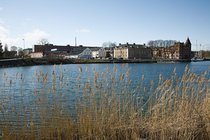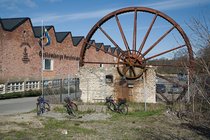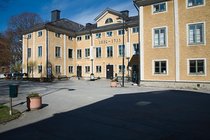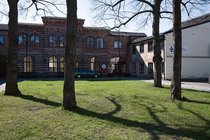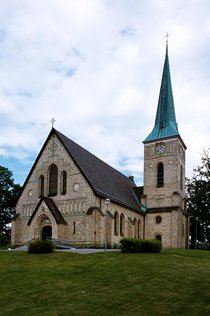Gustavsberg porcelain factory
The Gustavsberg porcelain factory is situated at Gustavsberg Harbour in industrial premises that date back to the 19th century. Porcelain has been manufactured here since the 1820s, and the industry is the reason that the community of Gustavsberg grew around the factory.
The factory site has been transformed and is today used for many activities, including the manufacture of porcelain (albeit at a smaller scale than previously).
The site of a brickworks
The site of the porcelain factory was previously a brickworks. This had been established during the 1640s to manufacture building material for the construction of the neighbouring Farsta Manor. The manor house was built during the time of Gustaf Gabriel Oxenstierna, and the community here is named after him. During the period in which Sweden was a major power and the expansion of the capital, the nobility built palaces and manor houses, and bricks were a valuable product. Bricks from the works here were delivered to Årsta Castle in Haninge, and was used for housing on the ridges of Stockholm. The manufacture of bricks continued in parallel with porcelain until the 1930s.
The creation of a porcelain works
In 1821 a merchant, Johan Herman Öhman, purchased Farsta and the brickworks, and founded the porcelain works at the site. The chamber of commerce awarded Öhman the right “to create and operate a factory for the manufacture of all types of porcelain” in 1825, and in 1827 the first items were fired. The establishment of a new porcelain works led to intensive building work, and many houses and factory buildings were erected. This was the start of the growth of Gustavsberg.
The community around the works
From the middle of the 19th and during the first decades of the 20th century, the Godenius and Odelberg families controlled the porcelain works. The factory expanded markedly under their leadership, and porcelain, which previously had been a luxury for the wealthy, achieved success among the wider public. At the turn of the century in 1900, over 800 people were employed at the works.
The highly organised community around the work grew during the Odelberg period: straight streets with workers’ homes were built, the factory was extended, shops and a school were built for the employees, and a church was raised.
KF takes over
The factory was sold after a period of decline to the Swedish Cooperative Union (Kooperativa förbundet) in 1937. New facilities were built that would support the manufacture of porcelain: in 1938-39 a factory for sanitary porcelain, where WCs and washbasins were made, and in 1947 the manufacture of bathtubs. The domestic porcelain factory was modernised during the period 1940-1948, and parts of the old factory were demolished to make space for one huge plant that housed all operations. The period 1965-1975 was very profitable for the Gustavsberg factories, since the enormous housing production that ocurred during an ambitious housing programme known as the “Million Programme” created a high demand for bathtubs, WCs and washbasins.
Transformation of the Gustavsberg site
As the production of housing declined, the Gustavsberg works experienced difficult times, and laid off many people. Acquisitions, mergers and closures followed. Sanitary porcelain is still manufactured at Gustavsberg, although on a smaller scale. The area otherwise has been transformed by other activities, and the old factory premises are used by many companies, shops, restaurants and artisans. Gustavsberg porslinsmuseum is now housed in Torkhuset, showing collections from the manufacture carried out at Gustavsbergs porslinsfabrik.
Links
Gustavsbergs porslinsmuseum
Gustavsbergs porslinsfabrik
Nearest public transport is the SL stop at Farstaviken, Gustavsberg..

